Chapter 10 Fundamentals of Anatomy and Physiology, 11e (Martini)
1/126
There's no tags or description
Looks like no tags are added yet.
Name | Mastery | Learn | Test | Matching | Spaced |
|---|
No study sessions yet.
127 Terms
1) Muscle tissue, one of the four basic tissue groups, consists chiefly of cells that are highly specialized for
A) conduction.
B) contraction.
C) peristalsis.
D) cushioning.
E) secretion.
B
2) Which of the following is a recognized function of skeletal muscle?
A) produce movement
B) maintain posture
C) maintain body temperature
D) guard body entrances and exits
E) All of the answers are correct.
E
3) At each end of the muscle, the collagen fibers of the epimysium, perimysium, and endomysium, come together to form a
A) tendon.
B) satellite cell.
C) ligament.
D) tenosynovium.
E) sheath.
A
4) The dense layer of connective tissue that surrounds an entire skeletal muscle is the A) tendon.
B) epimysium.
C) endomysium.
D) perimysium.
E) fascicle.
B
5) Nerves and blood vessels that service a muscle fiber are located in the connective tissues of its A) endomysium.
B) perimysium.
C) sarcolemma.
D) sarcomere.
E) myofibrils.
A
6) A fascicle is a
A) group of muscle fibers that are encased in the perimysium.
B) layer of connective tissue that separates muscle from skin.
C) group of muscle fibers that are all part of the same motor unit. D) group of muscle fibers and motor neurons.
E) collection of myofibrils in a muscle fiber.
A
7) The delicate connective tissue that surrounds the skeletal muscle fibers and ties adjacent muscle fibers together is the
A) endomysium.
B) perimysium.
C) epimysium.
D) superficial fascia.
E) periosteum.
A
8) The bundle of collagen fibers at the end of a skeletal muscle that attaches the muscle to bone is called a(n)
A) fascicle.
B) tendon.
C) ligament.
D) epimysium.
E) myofibril.
B
9) Put the following structures in order from superficial to deep.
1. muscle fiber
2. perimysium
3. myofibril
4. fascicle
5. endomysium
6. epimysium
A) 1, 5, 4, 3, 2, 6
B) 6, 2, 5, 4, 1, 3
C) 6, 2, 4, 5, 1, 3
D) 1, 3, 5, 6, 4, 2
E) 2, 3, 1, 4, 6, 5
C
10) A(n) ________ can be described as a broad tendinous sheet. A) fasciae
B) retinaculum
C) aponeurosis
D) interstitium
E) tympanum
C
11) Interactions between actin and myosin filaments of the sarcomere are responsible for A) muscle fatigue.
B) the conduction of neural stimulation to the muscle fiber.
C) muscle contraction.
D) muscle relaxation.
E) the striped appearance of skeletal muscle.
C
12) In a sarcomere, the central portion of thick filaments are linked laterally by proteins of the
A) Z line.
B) M line.
C) H band.
D) A band.
E) I band.
B
13) The advantage of having many nuclei in a skeletal muscle fiber is the ability to
A) contract much more forcefully.
B) produce more ATP with little oxygen.
C) store extra DNA for metabolism.
D) produce large amounts of muscle proteins. E) produce nutrients for muscle contraction.
D
14) Skeletal muscle fibers are formed from embryonic cells called
A) sarcomeres.
B) myofibrils.
C) myoblasts.
D) fascicles.
E) myomeres.
C
15) The repeating unit of a skeletal muscle fiber is the
A) sarcolemma.
B) sarcomere.
C) sarcoplasmic reticulum.
D) myofibril.
E) myofilament.
B
16) The plasma membrane of a skeletal muscle fiber is called the A) sarcolemma.
B) sarcomere.
C) sarcosome.
D) sarcoplasmic reticulum.
E) sarcoplasm.
A
17) Which of the following best describes the term sarcomere?
A) protein that accounts for elasticity of resting muscle
B) repeating unit of striated myofibrils
C) storage site for calcium ions
D) thin filaments are anchored here
E) largely made of myosin molecules
B
18) Muscle fibers differ from "typical cells" in that muscle fibers
A) lack a plasma membrane.
B) have many nuclei.
C) are very small.
D) lack mitochondria.
E) have large gaps in the cell membrane.
B
19) Which of the following best describes the term sarcoplasmic reticulum?
A) protein that accounts for elasticity of resting muscle
B) repeating unit of striated myofibrils
C) storage and release site for calcium ions
D) thin filaments are anchored here
E) largely made of myosin molecules
C
20) Which of the following best describes the term Z line?
A) protein that accounts for elasticity of resting muscle
B) repeating unit of striated myofibrils
C) storage site for calcium ions
D) thin filaments are anchored here
E) largely made of myosin molecules
D
21) The region of the sarcomere containing the thick filaments is the
A) Z line.
B) M line.
C) H band.
D) A band.
E) I band.
D
22) The skeletal muscle complex known as the triad consists of
A) actin, myosin, and titin filaments.
B) a transverse tubule and two terminal cisternae.
C) filaments, myofibrils, and sarcomeres.
D) A bands, H bands, and I bands. E) actin, myosin, and sarcomeres.
B
23) The area in the center of the A band that contains no thin filaments is the
A) Z line.
B) M line.
C) H band.
D) I band.
E) zone of overlap.
C
24) At rest, the tropomyosin molecule is held in place by
A) actin molecules.
B) myosin molecules.
C) troponin molecules.
D) ATP molecules.
E) calcium ions.
C
25) Each thin filament consists of
A) two actin protein strands coiled helically around each other. B) chains of myosin molecules.
C) six molecules coiled into a helical structure.
D) a rod-shaped structure with "heads" projecting from each end. E) a double strand of myosin molecules.
A
26) The region of the sarcomere that always contains thin filaments is the
A) Z line.
B) M line.
C) H band.
D) A band.
E) I band.
E
27) At rest, active sites on the actin are blocked by
A) myosin molecules.
B) troponin molecules.
C) tropomyosin molecules.
D) calcium ions.
E) ATP molecules.
C
28) The series of membranous channels that surround each myofibril is the
A) sarcoplasmic reticulum.
B) sarcoplasm.
C) sarcomere.
D) sarcolemma.
E) endomysium.
A
29) All of the following proteins are part of the thin filaments except
A) actin.
B) tropomyosin.
C) troponin.
D) titin.
E) None of the answers is correct; there are no exceptions.
D
30) When a skeletal muscle fiber contracts, the
A) H bands and I bands get larger.
B) zones of overlap get larger.
C) Z lines move further apart.
D) width of the A band increases.
E) All of the answers are correct.
B
31) Since each myofibril is attached at either end of the muscle fiber, when sarcomeres shorten, the muscle fiber
A) lengthens.
B) shortens.
C) strengthens.
D) weakens.
E) pulls from the middle.
B
32) Identify the structure labeled "1."
A) mitochondria
B) glycogen
C) ATP
D) myofibril
E) synaptic vesicle
A
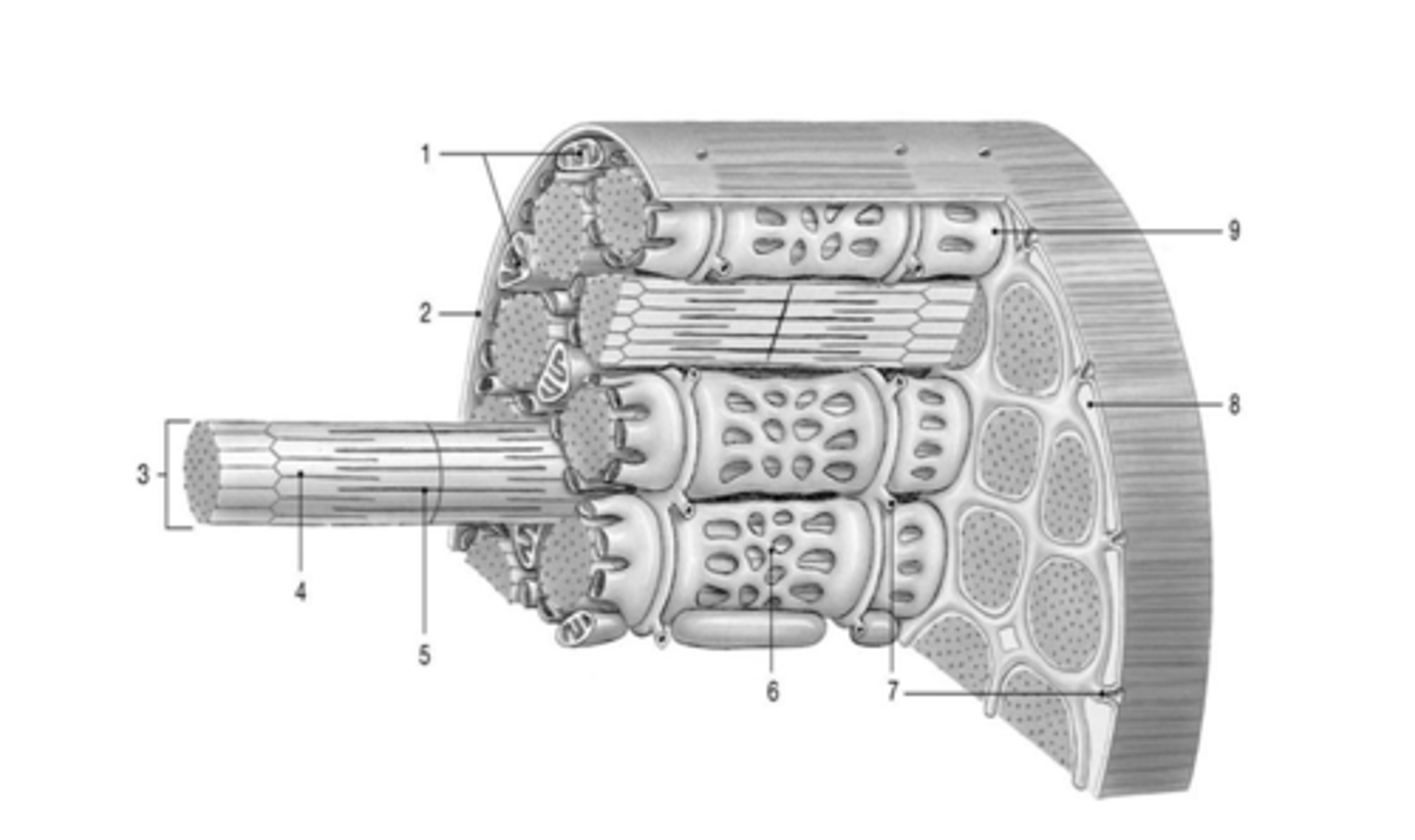
33) Which of the following are found in the structure labeled "3"?
A) actin
B) myosin
C) titin
D) tropomyosin
E) All of the answers are correct.
E
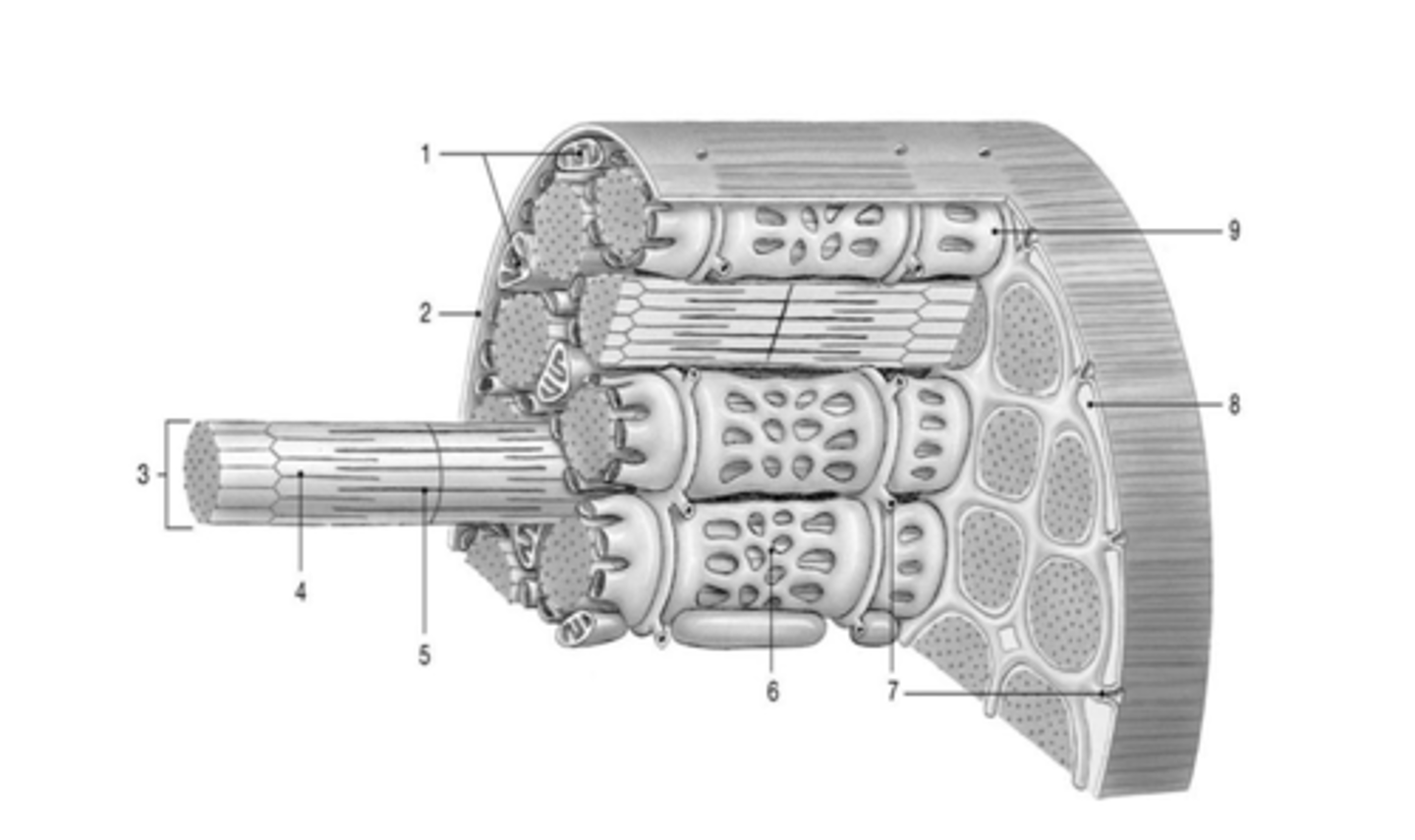
34) What physiological process occurs in the structure labeled "7"?
A) release of neurotransmitter
B) conduction of the action potential into the cell interior
C) activity of acetylcholinesterase
D) release of protein and calcium ions into the muscle fiber
E) opening of sodium channels and subsequent influx of sodium
B
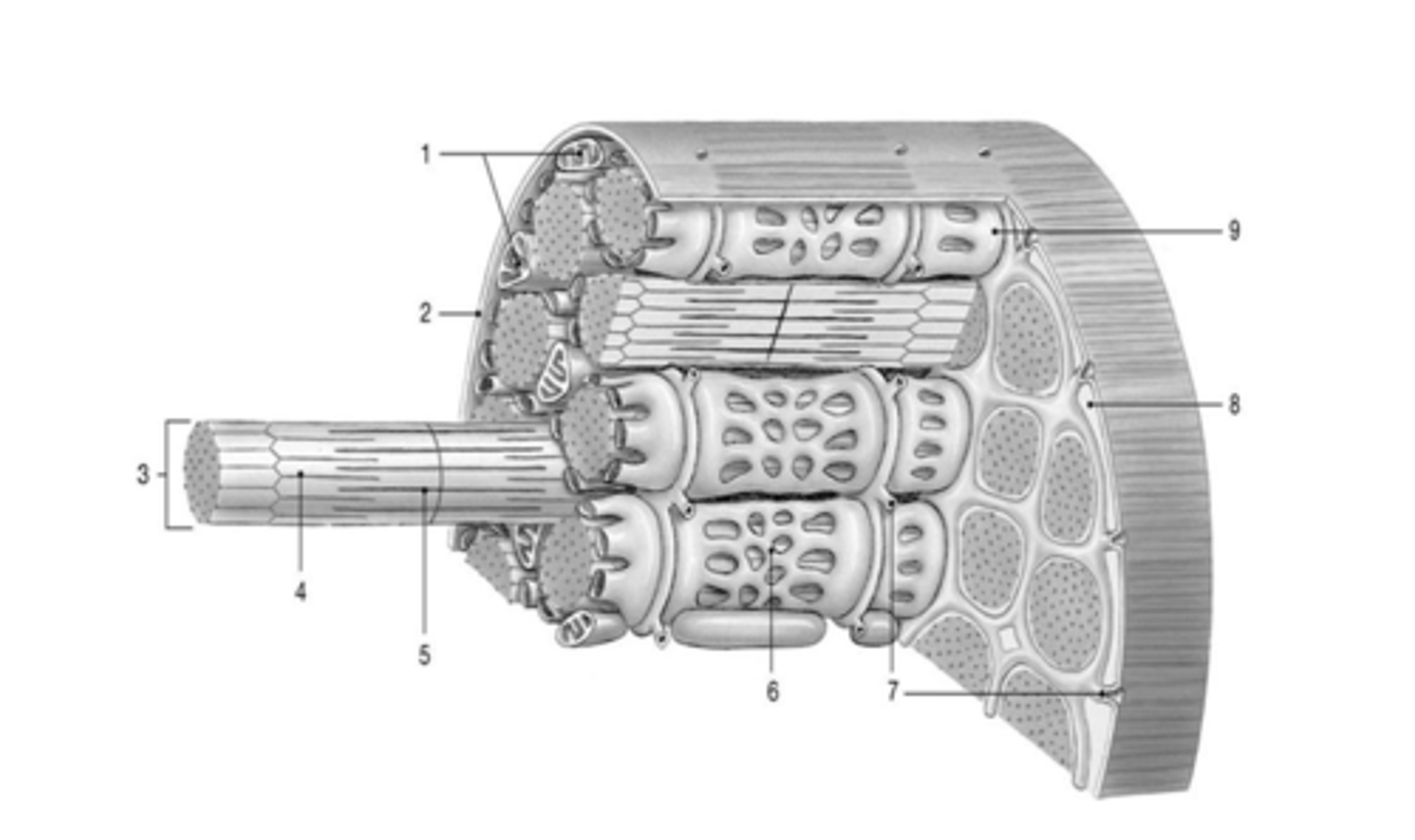
35) What is released from the structure labeled "9"?
A) sarcoplasm
B) acetylcholine
C) protein
D) calcium ions
E) acetylcholinesterase
D
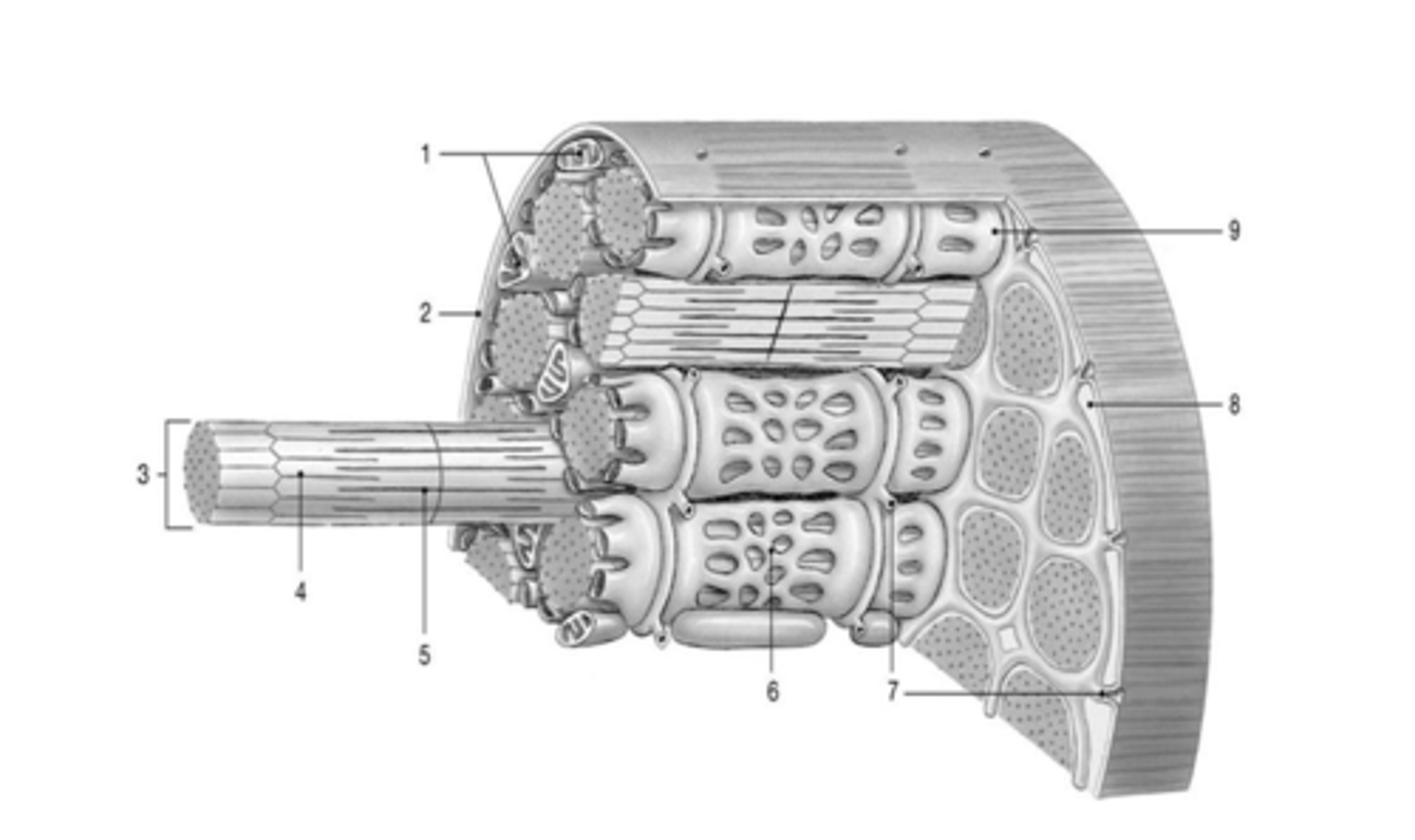
36) Where would calcium ions be predominately found?
A) 1
B) 2
C) 4
D) 8
E) 9
E
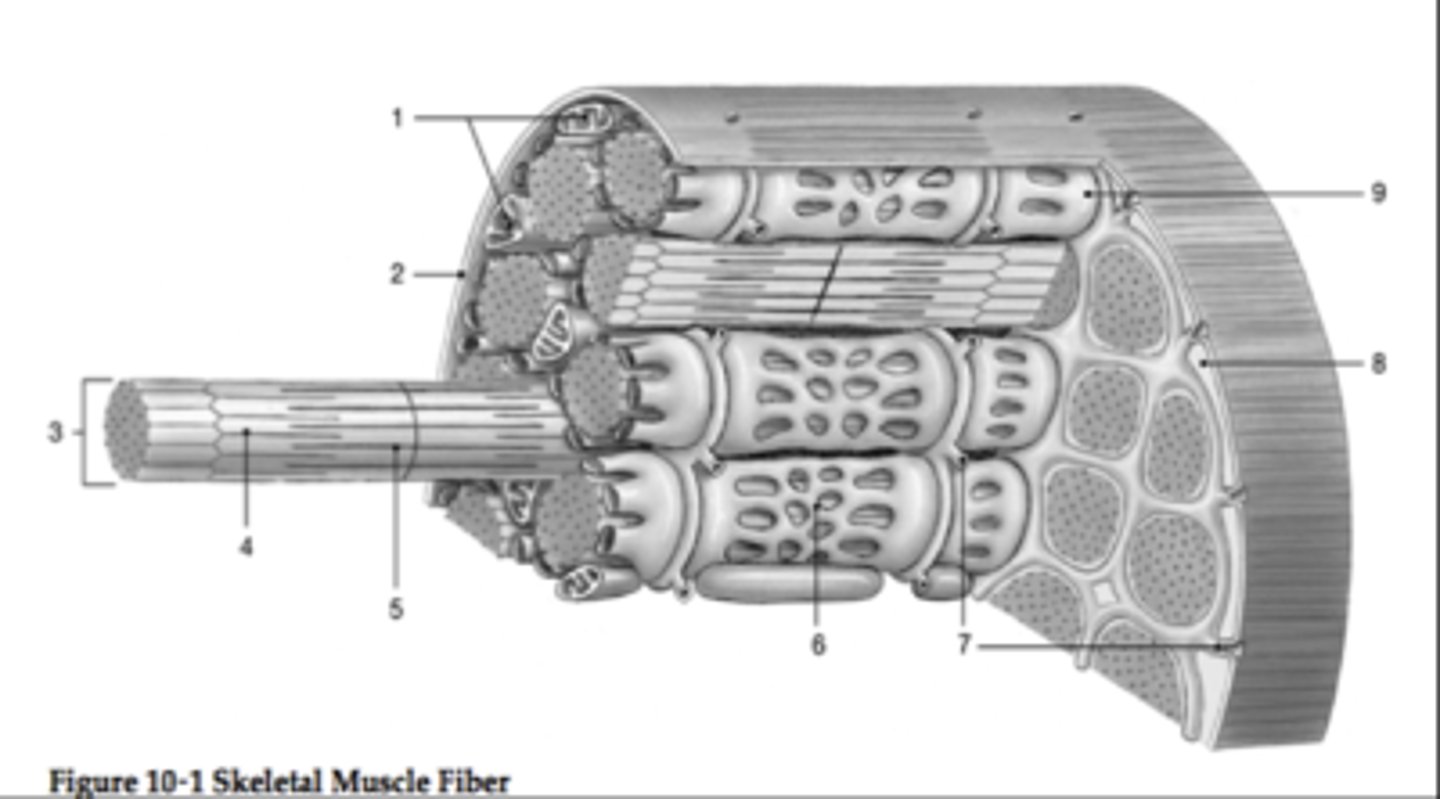
37) Which structure has pumps to remove calcium ions from the sarcoplasm to produce relaxation?
A) 6
B) 7
C) 1
D) 3
E) 2
A
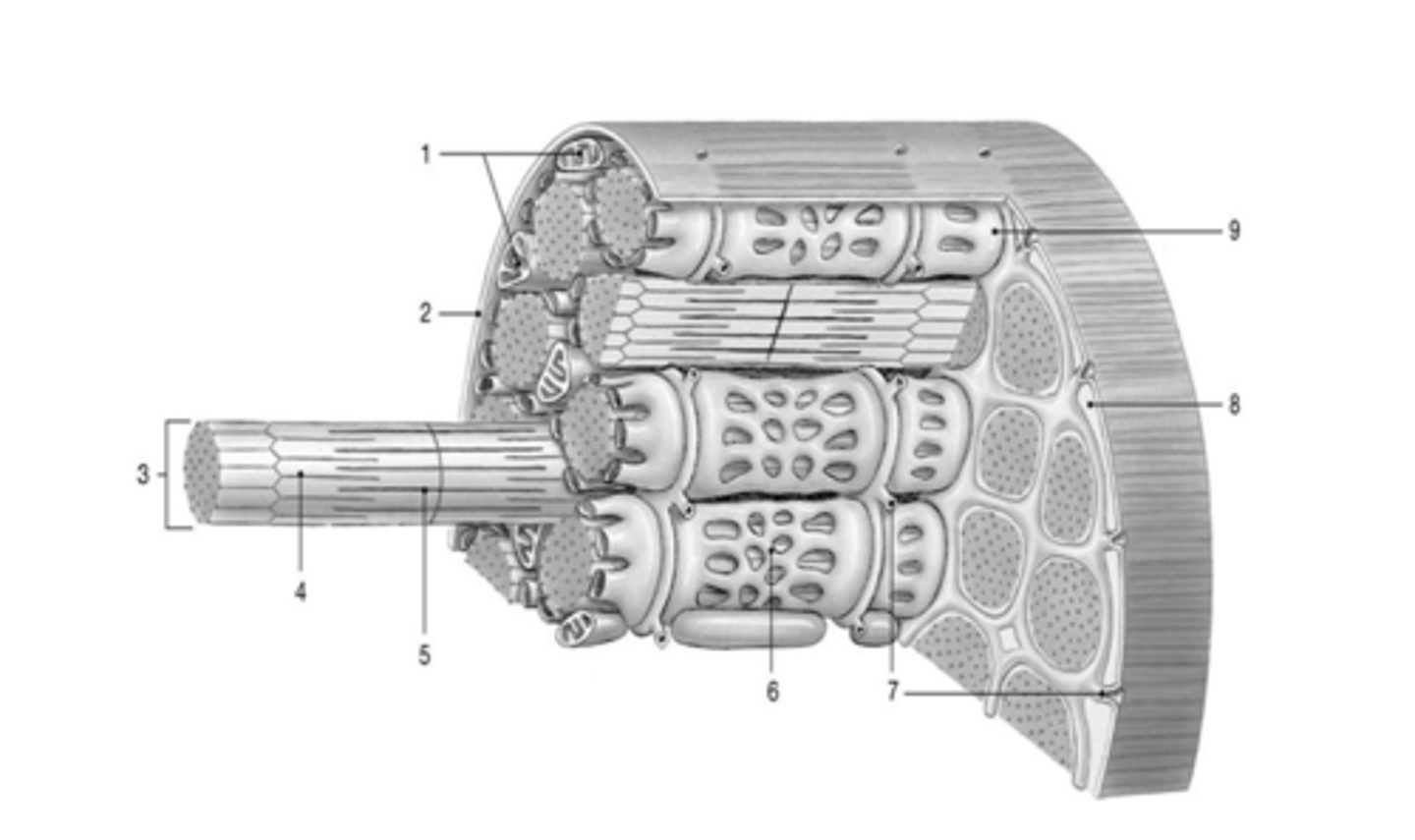
38) Where are the myosin molecules located?
A) 4
B) 5
C) 6
D) 7
E) 8
B
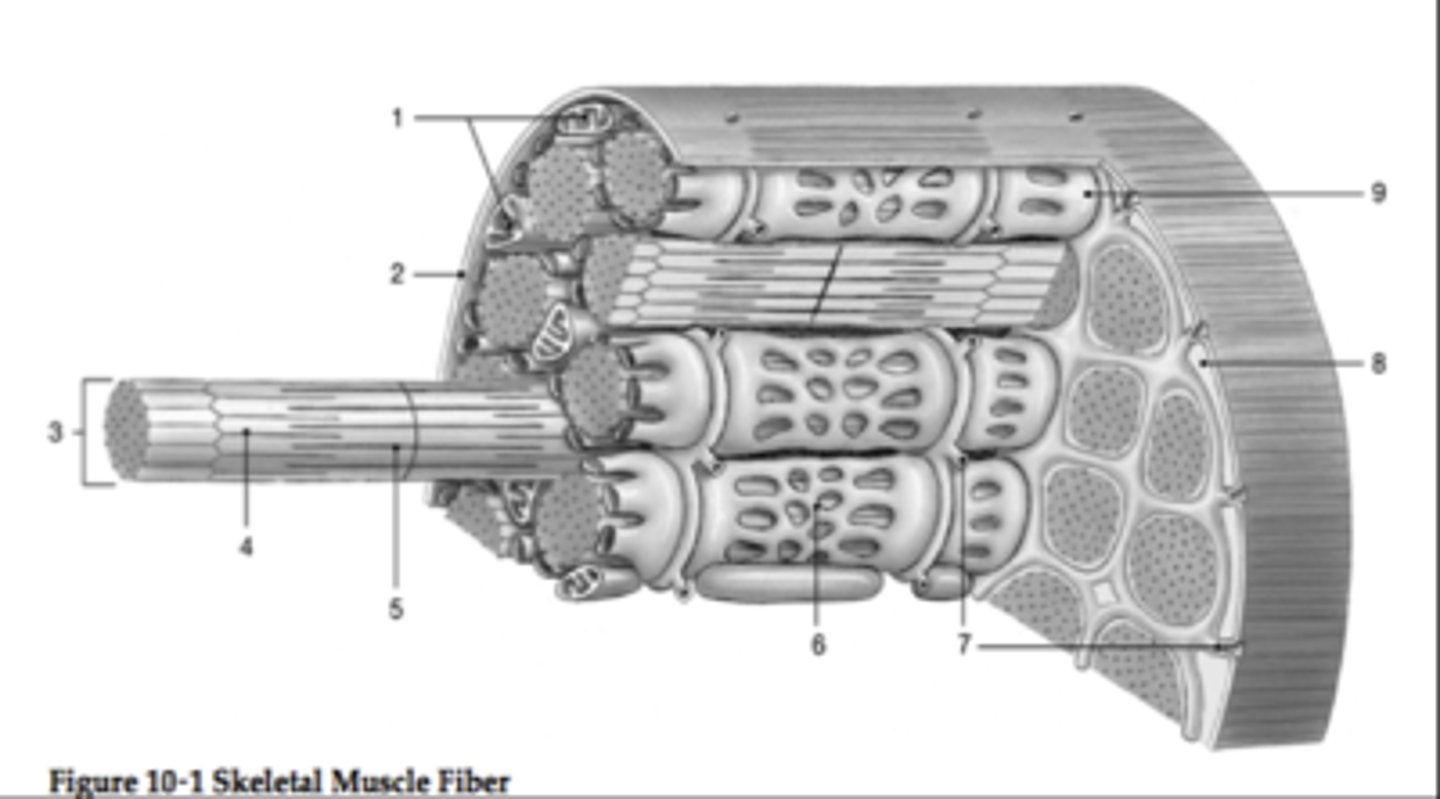
39) Which structure contains the motor end plate?
A) 1
B) 2
C) 3
D) 5
E) 8
B
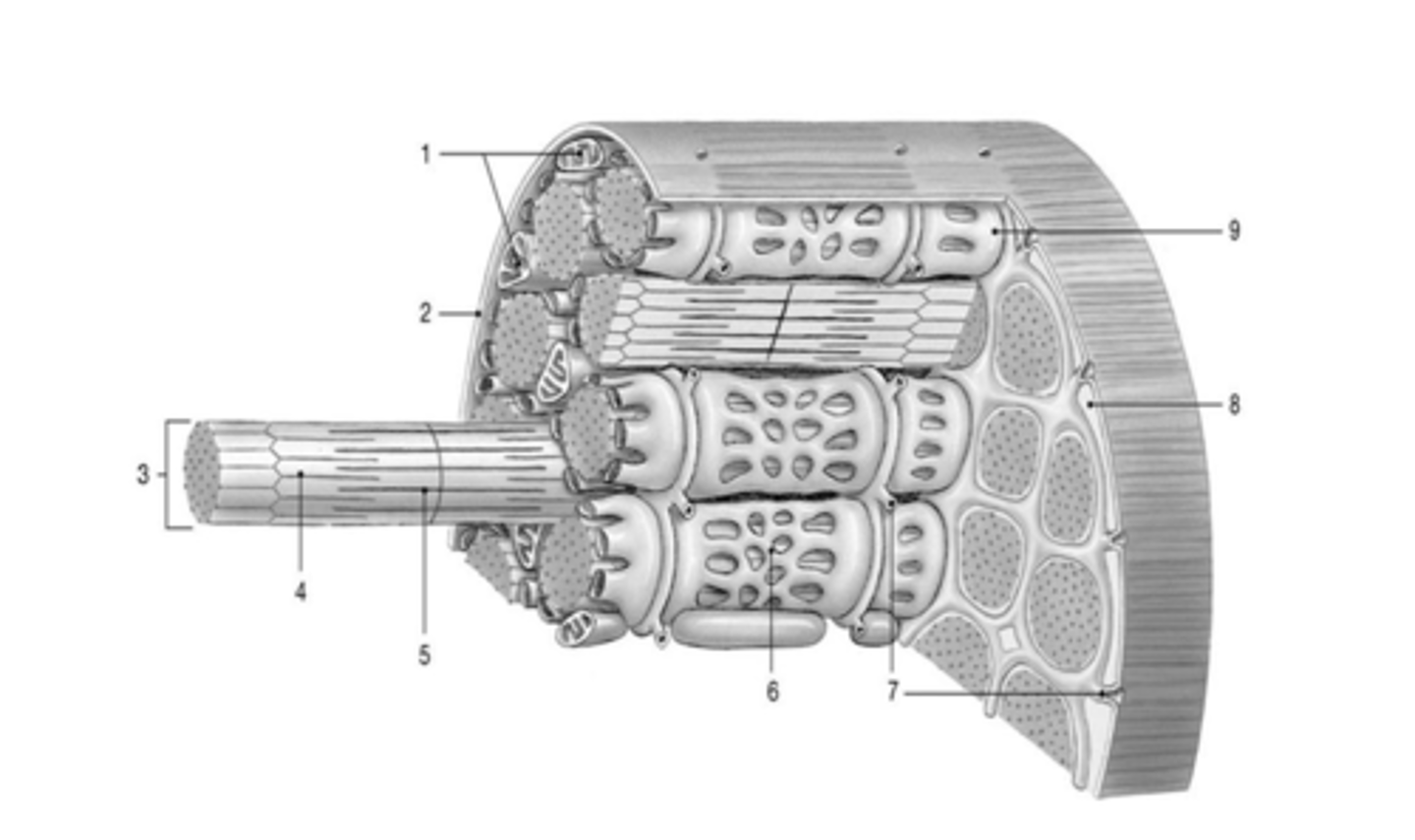
40) Identify the structure where ATP is produced. A) 6
B) 7
C) 1
D) 3
E) 2
C
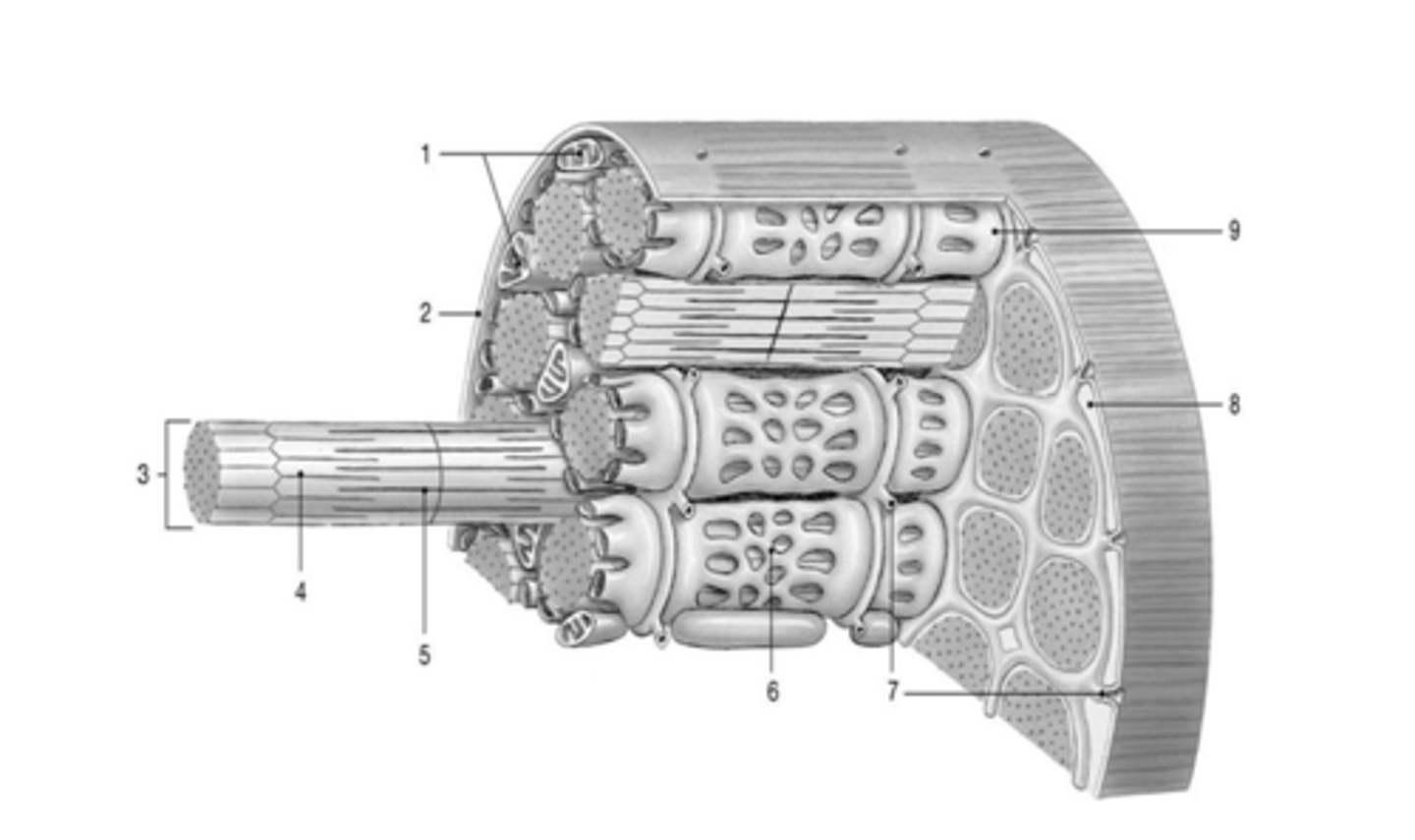
V\41) Identify the structure(s) where ATP is consumed?
A) 3
B) 6
C) 3 and 6
D) 7
E) 3 and 7
C
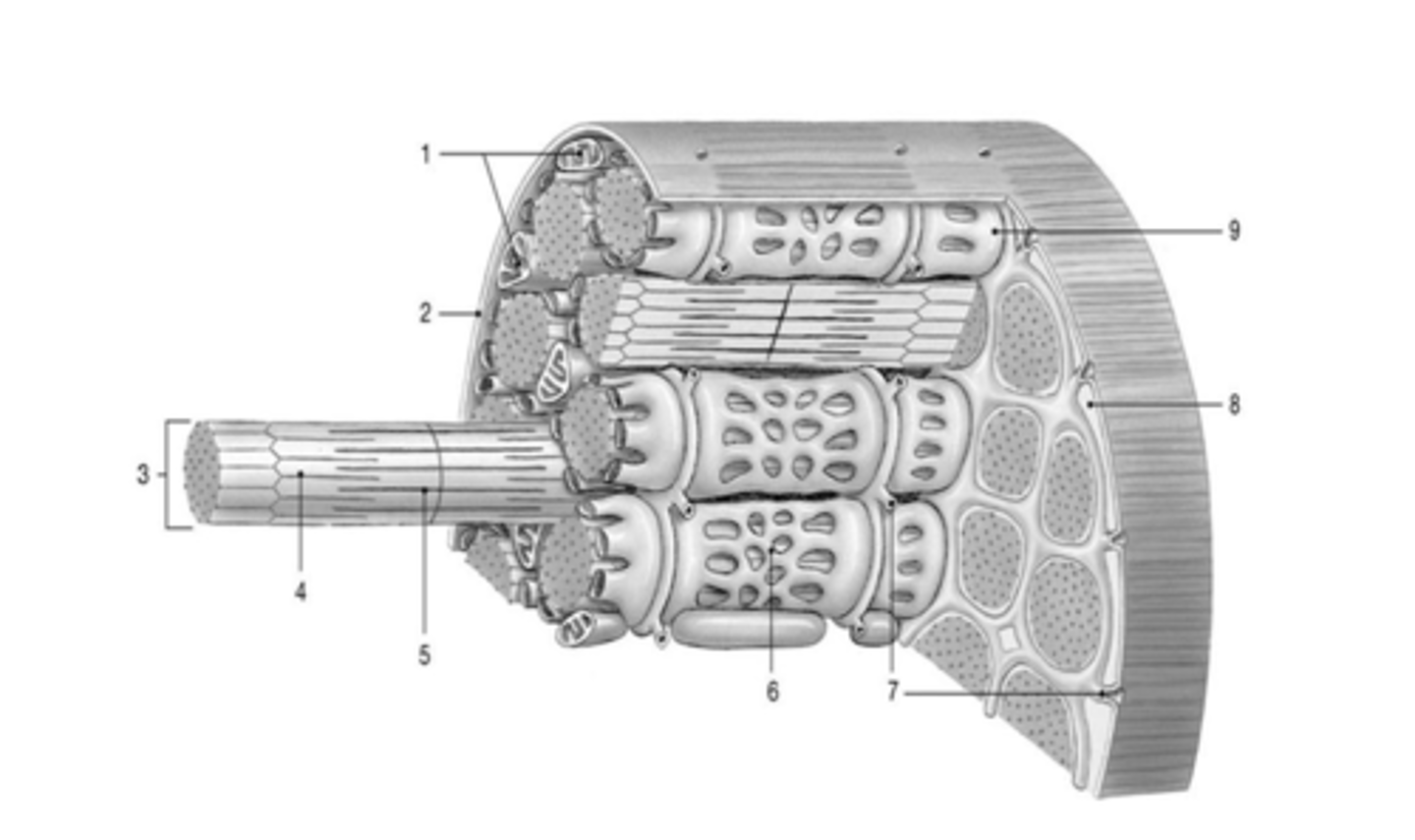
42) Active sites on the actin become available for binding after
A) actin binds to troponin.
B) troponin binds to tropomyosin.
C) calcium binds to troponin.
D) calcium binds to tropomyosin. E) myosin binds to troponin.
C
43) The action potential is conducted into a skeletal muscle fiber by
A) motor end plates.
B) neuromuscular junctions.
C) transverse tubules.
D) triads.
E) sarcoplasmic reticulum.
C
44) The most important factor in decreasing the intracellular concentration of calcium ion after contraction is
A) active transport of calcium across the sarcolemma.
B) active transport of calcium into the sarcoplasmic reticulum.
C) active transport of calcium into the synaptic cleft.
D) diffusion of calcium out of the cell.
E) diffusion of calcium into the sarcoplasmic reticulum.
B
45) When calcium ion binds to troponin,
A) tropomyosin rolls away from the active site.
B) active sites on the myosin are exposed.
C) actin heads will bind to myosin.
D) muscle relaxation occurs.
E) myosin shortens.
A
46) Physical evidence that supports the sliding filament theory of muscle contraction includes
A) constant distance between Z lines during contraction.
B) decreased width of the H band during contraction.
C) increased width of the I band during contraction.
D) decreased width of the A band during contraction.
E) the I band + H band distance is constant during contraction.
B
47) The protein that is found in the Z line of a sarcomere is called
A) actinin.
B) titin.
C) nebulin.
D) myosin.
E) actin
A
48) The protein that regulates muscle contraction by controlling the availability of active sites on actin is called
A) actin.
B) titin.
C) myosin.
D) tropomyosin.
E) nebulin.
D
49) Thin filaments are mostly made of the protein
A) actin.
B) titin.
C) myosin.
D) tropomyosin.
E) nebulin.
A
50) Thick filaments are made of the protein
A) actin.
B) titin.
C) myosin.
D) tropomyosin.
E) nebulin
C
51) Stem cells located between the endomysium and sarcolemma that function in the repair of damaged muscle tissue are called
A) myocytes.
B) satellite cells.
C) endocytes.
D) sarcocytes.
E) creatinocytes.
B
52) The complex of a transverse tubule and two adjacent terminal cisternae is known as a A) trimer.
B) triad.
C) triptych.
D) trisome.
E) trilogy.
B
53) The structural theory that explains how a muscle fiber contracts is called the ________ theory.
A) sliding filament
B) excitation-contraction coupling
C) neuromuscular
D) muscle contraction
E) action-myosin interaction
A
54) The region of sarcomere where thin and thick filaments are located is called the
A) I band.
B) A band.
C) Z line.
D) M line.
E) zone of overlap.
E
55) In the sarcomere which elastic protein attaches the thick filament to the Z line?
A) titin
B) actin
C) G actin
D) nebulin
E) myosin
A
56) In the sarcomere the protein that forms two twisted strands around a central rod-like protein is called
A) titin.
B) actin.
C) G actin.
D) nebulin.
E) myosin.
B
57) In the myofibril the protein that possesses the active site for myosin heads to bind is called A) titin.
B) actin.
C) G actin.
D) nebulin.
E) myosin.
C
58) In the myofibril the thin filament is organized around a rod-like core protein called
A) titin.
B) actin.
C) G actin.
D) Nebulin
e)myosin
D
59) In response to action potentials arriving along the transverse tubules, the sarcoplasmic reticulum releases
A) acetylcholine.
B) sodium ions.
C) potassium ions.
D) calcium ions.
E) hydrogen ions.
D
60) Each skeletal muscle fiber is controlled by a motor neuron at a single
A) synaptic knob.
B) sarcomere.
C) neuromuscular junction.
D) synaptic cleft.
E) transverse tubule.
C
61) The narrow space between the synaptic terminal and the muscle fiber is the
A) synaptic knob.
B) motor end plate.
C) motor unit.
D) synaptic cleft.
E) M line.
D
62) Which of the following become connected by myosin cross-bridges during muscle contraction?
A) thin filaments and thick filaments
B) thick filaments and titin filaments
C) z disks and actin filaments
D) thick filaments and t-tubules
E) thin filaments and t-tubules
A
63) After death, muscle fibers run out of ATP and calcium begins to leak from the sarcoplasmic reticulum into the sarcoplasm. This results in a condition known as
A) tetany.
B) treppe.
C) depolarization.
D) rigor mortis.
E) oxygen debt.
D
64) In rigor mortis
A) the myosin heads are attached to actin.
B) ATP is depleted.
C) calcium ions keep binding to troponin.
D) sustained contractions occur.
E) All of the answers are correct.
E
65) In a sarcomere, cross-bridge attachment occurs specifically in the
A) zone of overlap.
B) A band.
C) I band.
D) M line.
E) H band.
A
66) Triggering of the muscle action potential occurs after
A) acetylcholine binds to chemically-gated channels in the motor end plate.
B) acetylcholinesterase is released from synaptic vesicles into the synaptic cleft.
C) calcium ion binds to channels on the motor end plate.
D) the action potential jumps across the neuromuscular junction.
E) Any of these can produce an action potential in the muscle cell.
A
67) The following is a list of the events that occur during a muscle contraction. What is the correct sequence of these events?
1. Myosin cross-bridges bind to the actin.
2. The free myosin head splits ATP.
3. Calcium ion is released from the sarcoplasmic reticulum.
4. The myosin head pivots toward the center of the sarcomere.
5. Calcium ion binds to troponin.
6. The myosin head binds an ATP molecule and detaches from the actin.
A) 1, 3, 5, 4, 6, 2
B) 5, 1, 4, 6, 2, 3
C) 3, 5, 1, 2, 4, 6
D) 3, 5, 1, 4, 6, 2
E) 1, 4, 6, 2, 3, 5
D
68) How would the loss of acetylcholinesterase from the motor end plate affect skeletal muscle?
A) It would make the muscles less excitable.
B) It would produce muscle weakness.
C) It would cause muscles to stay contracted.
D) It would cause muscles to stay relaxed.
E) It would have little effect on skeletal muscles.
C
69) When acetylcholine binds to receptors at the motor end plate, the sarcolemma becomes A) more permeable to sodium ions.
B) less permeable to sodium ions.
C) more permeable to calcium ions.
D) less permeable to potassium ions.
E) less permeable to potassium and sodium ions.
A
70) The cytoplasm of the neuromuscular terminal contains vesicles filled with molecules of the neurotransmitter
A) epinephrine.
B) norepinephrine.
C) acetylcholine.
D) antidiuretic hormone.
E) adrenaline.
C
71) At what point during excitation contraction coupling does exocytosis play a role?
A) during calcium ion reuptake into the sarcoplasmic reticulum
B) when sodium channels open up on the motor end plate
C) during acetylcholine release from the synaptic terminal
D) when the action potential surges through the T-tubules
E) when ATP splits into ADP and P on the free myosin head
C
72) Which of the following statements about excitation-contraction coupling is incorrect?
A) Calcium ions travel through the transverse tubule.
B) Calcium ion is released from the sarcoplasmic reticulum.
C) Tropomyosin moves to expose myosin binding sites on actin.
D) Troponin binds calcium ion and signals tropomyosin to move.
E) Relaxation requires uptake of calcium ion by the sarcoplasmic reticulum.
A
73) Synaptic vesicles contain neurotransmitters that are released by ________ when the action potential arrives.
A) endocytosis
B) apoptosis
C) exocytosis
D) hydrolysis
E) sodium
C
74) A patient takes a medication that blocks ACh receptors of skeletal muscle fibers. What is this drug's effect on skeletal muscle contraction?
A) increases tone in the muscle
B) causes a strong contraction similar to a "charlie horse" cramp
C) increases the muscle's excitability
D) produces a strong, continuous state of contraction E) reduces the muscle's ability for contraction
E
75) Communication between axons and muscle fibers occurs at specialized synapses called A) nervous units.
B) synaptic terminals.
C) motor end plates.
D) motor units.
E) neuromuscular junctions.
E
76) Active sites become exposed when calcium ions bind to
A) tropomyosin.
B) actin.
C) myosin.
D) troponin.
E) calcium channels.
D
77) Cross bridge detachment is caused by ________ binding to the myosin head.
A) ATP
B) calcium
C) magnesium
D) acetylcholine
E) acetylcholinesterase
A
78) The sequence of processes that links the action potential to contraction is called
A) neuromuscular junction.
B) action potential propagation.
C) excitation-contraction coupling.
D) cross bridge formation.
E) sliding filament theory.
C
79) The role of acetylcholinesterase is to
A) bind to ligand gated sodium channels.
B) activate acetylcholine.
C) release acetylcholine into the synaptic cleft.
D) transport acetylcholine across the synaptic cleft.
E) break down acetylcholine into acetate and choline components.
E
80) Which of the following is not true of acetylcholine?
A) It binds to receptor membrane channels.
B) It diffuses across the synaptic cleft.
C) It is stored in the neuron in vesicles.
D) It enters the muscle fiber to release calcium form the sarcoplasmic reticulum.
E) It is digested by acetylcholinesterase
D
81) Put the following events of excitation-contraction coupling in the order in which they occur. 1. Excitation
2. Sarcomere shortening
3. Generation of muscle tension
4. Neural control
5. Contraction cycle begins
6. Release of calcium ions
A) 4,1,5,2,6,3
B) 4,1,6,5,2,3
C) 1,2,5,6,3,4
D) 6,1,4,2,5,3
E) 1,4,6,2,5,3
B
82) Put the following events of the neuromuscular junction in the order in which they occur. 1. Action potential is propagated in the sarcolemma.
2. Acetylcholine binds to ligand gated sodium channels.
3. Action potential arrives at the neuromuscular junction.
4. Vesicles full of acetylcholine are stored at the axon terminal. 5. Acetylcholine is released into the synaptic cleft.
A) 4,3,5,2,1
B) 4,3,5,1,2
C) 4,5,3,2,1
D) 4,3,1,5,2
E) 4,1,3,2,5
A
83) Put the following events of the contraction cycle in the order in which they occur. 1. Cross-bridge detachment
2. Cross-bridge formation
3. Active site exposure
4. Myosin reactivation
5. Calcium ions bind troponin
6. Myosin head pivoting
A) 5,3,6,2,1,4
B) 5,3,2,6,4,1
C) 5,3,2,6,1,4
D) 5,3,6,2,4,1
E) 3,5,2,6,1,4
C
84) The rapid rise and fall in force produced by a muscle fiber after a single action potential is a(n)
A) tetanus.
B) unfused tetanus.
C) twitch.
D) motor end plate potential.
E) muscle action potential.
C
85) When a muscle is stimulated repeatedly at a high rate, the amount of tension gradually increases to a steady maximum tension. This state of maximum tension is called
A) incomplete tetanus.
B) complete tetanus.
C) a twitch.
D) wave summation.
E) recruitment.
B
86) A muscle producing almost peak tension during rapid cycles of contraction and relaxation is said to be in
A) incomplete tetanus.
B) complete tetanus.
C) treppe.
D) wave summation.
E) recruitment.
A
87) If a second stimulus arrives before the relaxation phase has ended, a second, more powerful contraction occurs. This addition of one twitch to another is called
A) incomplete tetanus.
B) complete tetanus.
C) treppe.
D) wave summation.
E) recruitment.
D
88) What is the contraction in graph (a) called?
A) complete tetanus
B) incomplete tetanus
C) twitch
D) wave summation
E) treppe
E
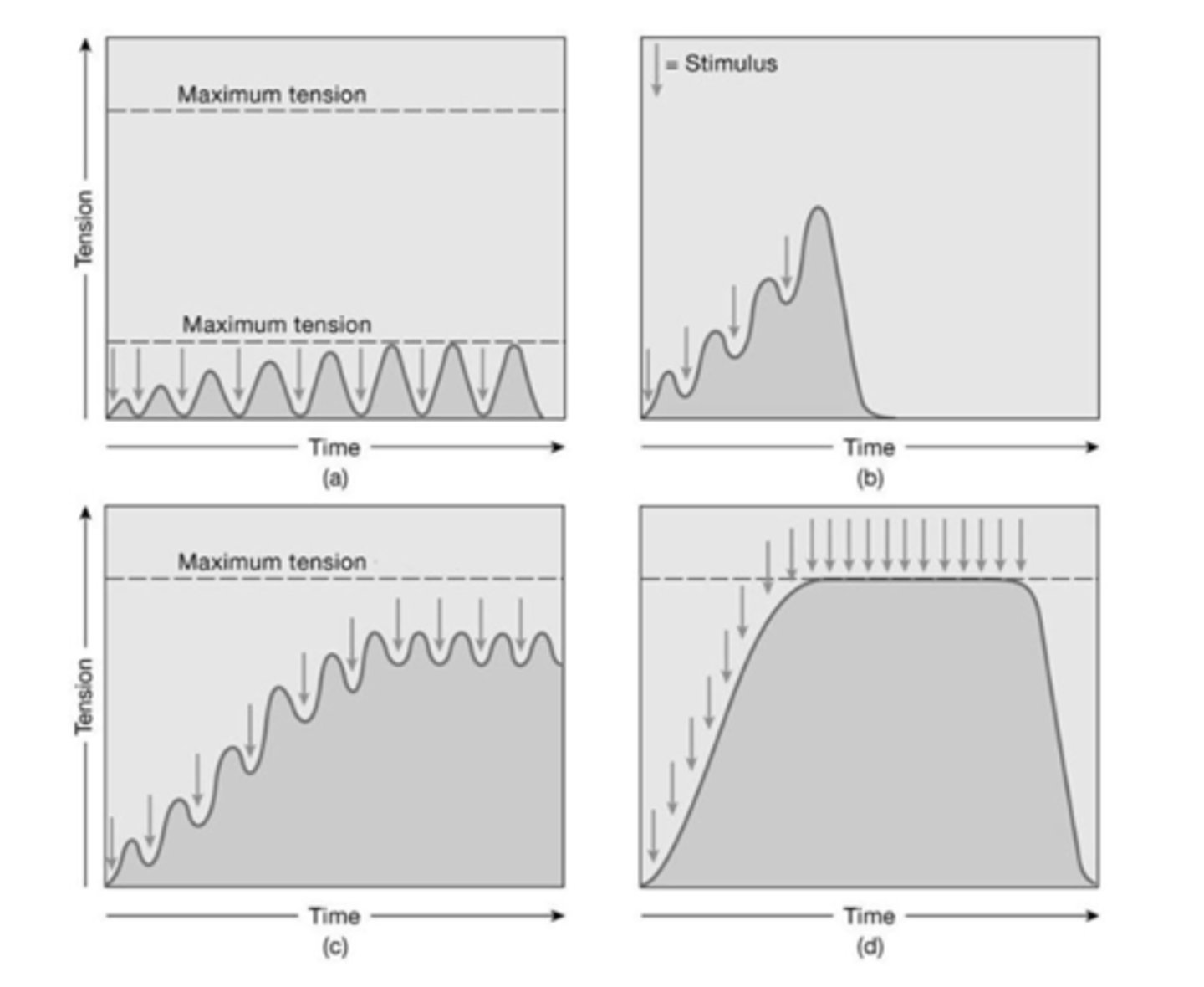
89) What is thought to happen in a muscle during the response shown in graph (a)? A) It is strengthening with exercise.
B) There is a gradual increase in calcium ion concentration in the sarcoplasm.
C) It is fatigued and must make repeated efforts to twitch normally.
D) It is aged and has lost contractile proteins.
E) It is producing more ATP as tension increases.
B
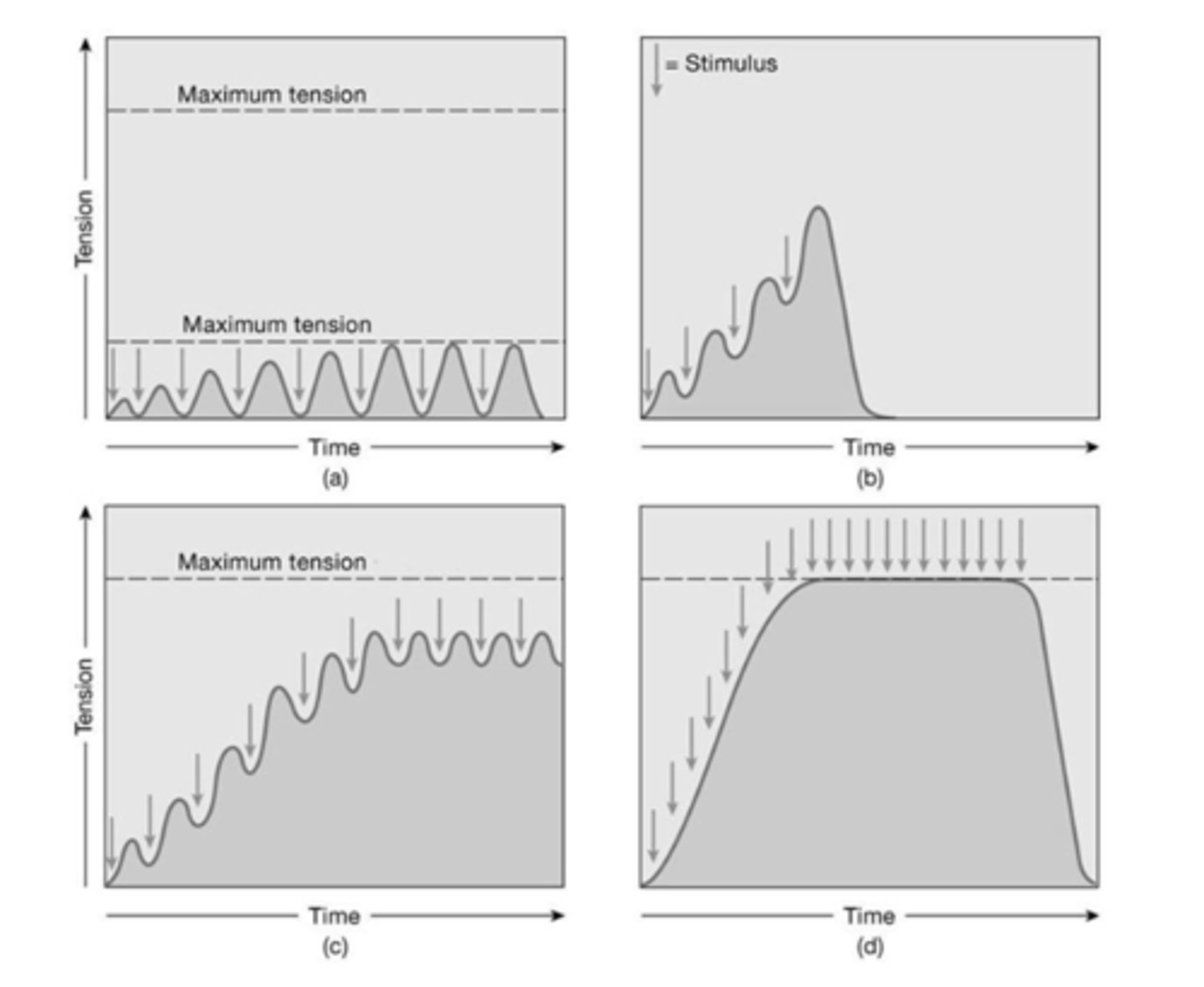
90) To produce a contraction similar to the one in graph (b), the muscle
A) must be stimulated to the point of fatigue.
B) must be stimulated again before it has relaxed from the previous stimulation.
C) is excited by a stimulus of increasing intensity.
D) must go through a rapid series of isolated twitches.
E) generates more and more thin and thick filaments.
B
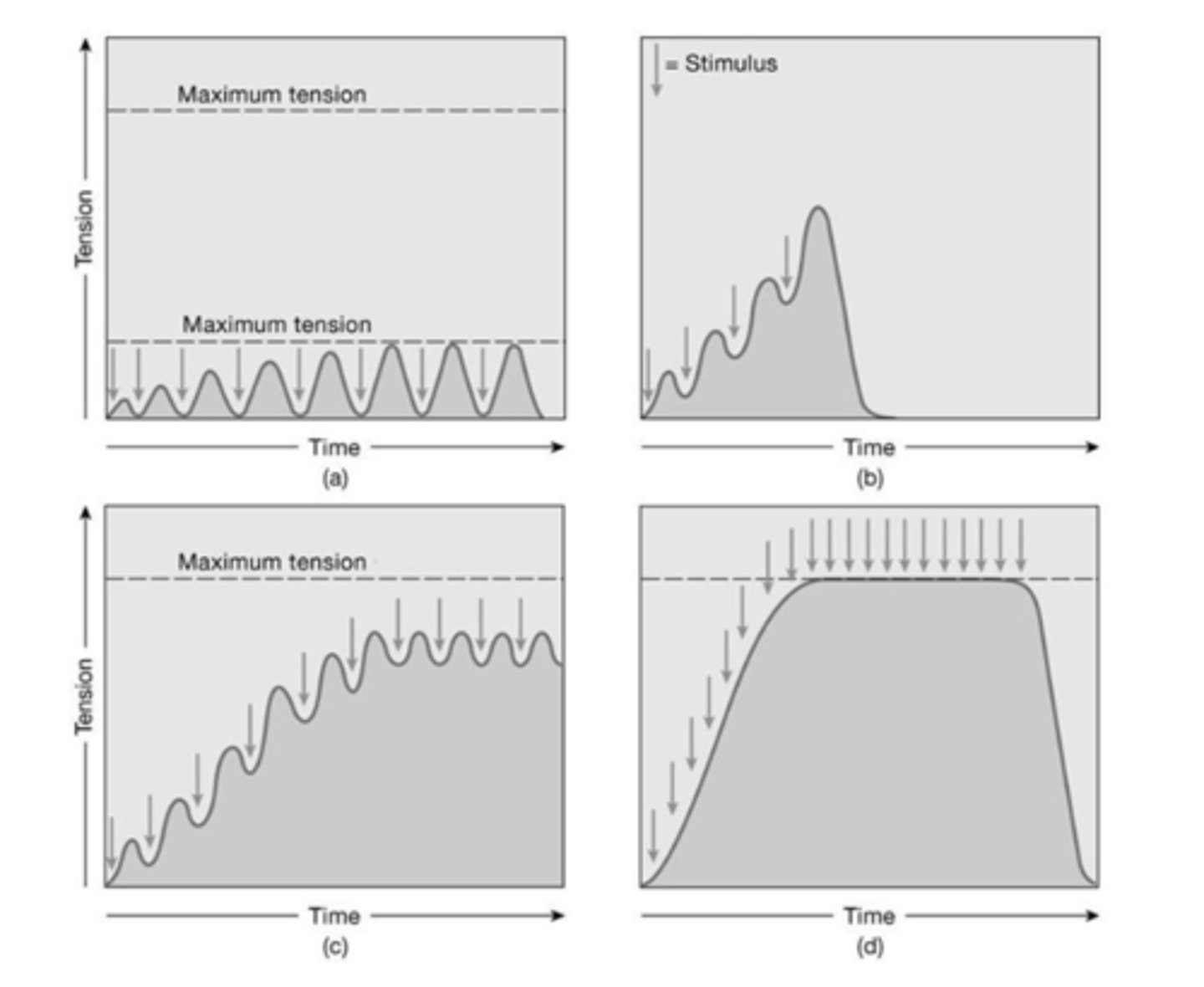
91) Why is there partial relaxation in graph (c)?
A) Calcium ion release is slow.
B) The muscle is starting to fatigue.
C) Stimulation intensity is fluctuating.
D) ATP reserves are cycling.
E) Nerve stimulation frequency is below maximum.
E
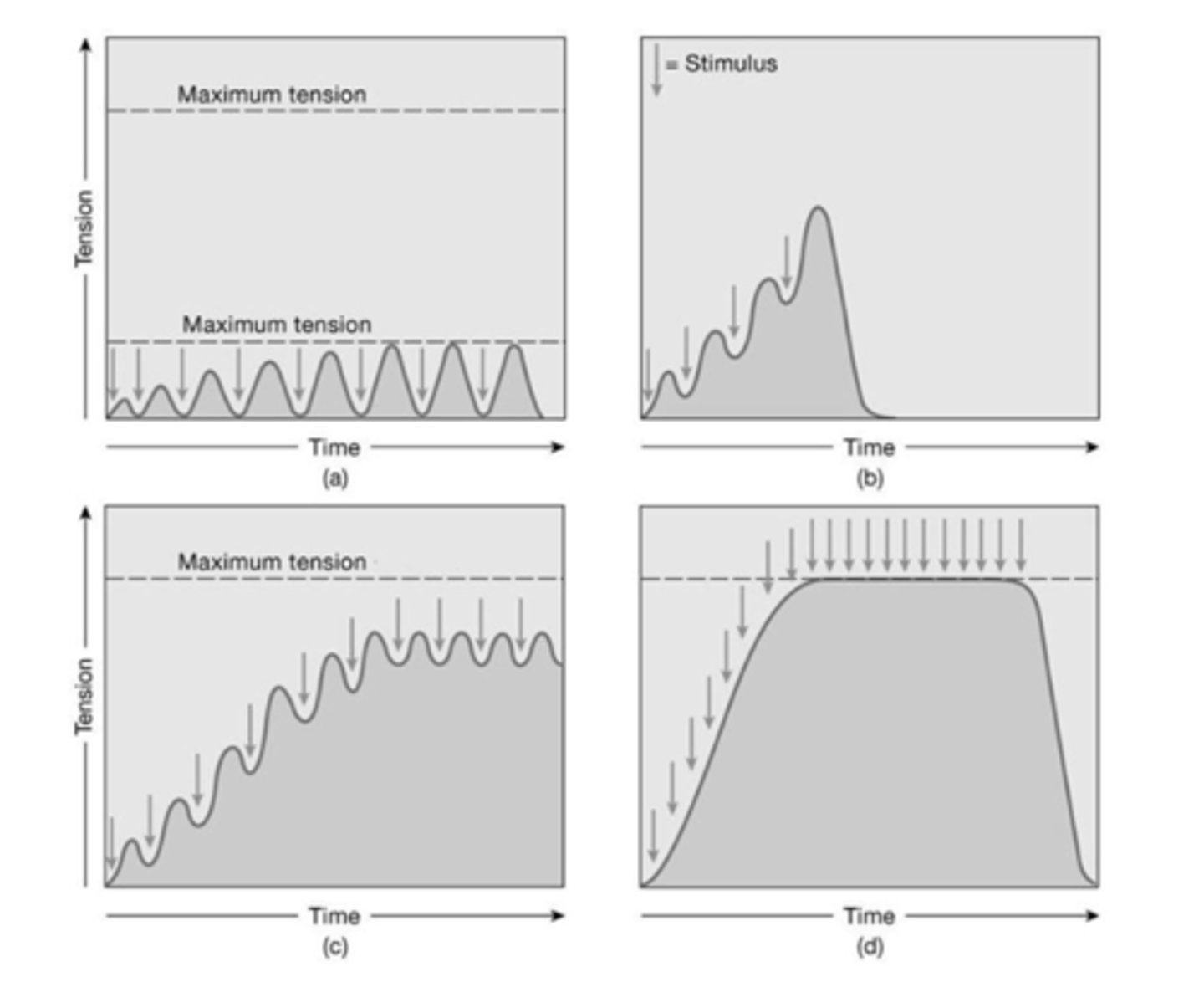
92) What is the contraction in graph (d) called?
A) complete tetanus
B) incomplete tetanus
C) twitch
D) wave summation
E) treppe
A
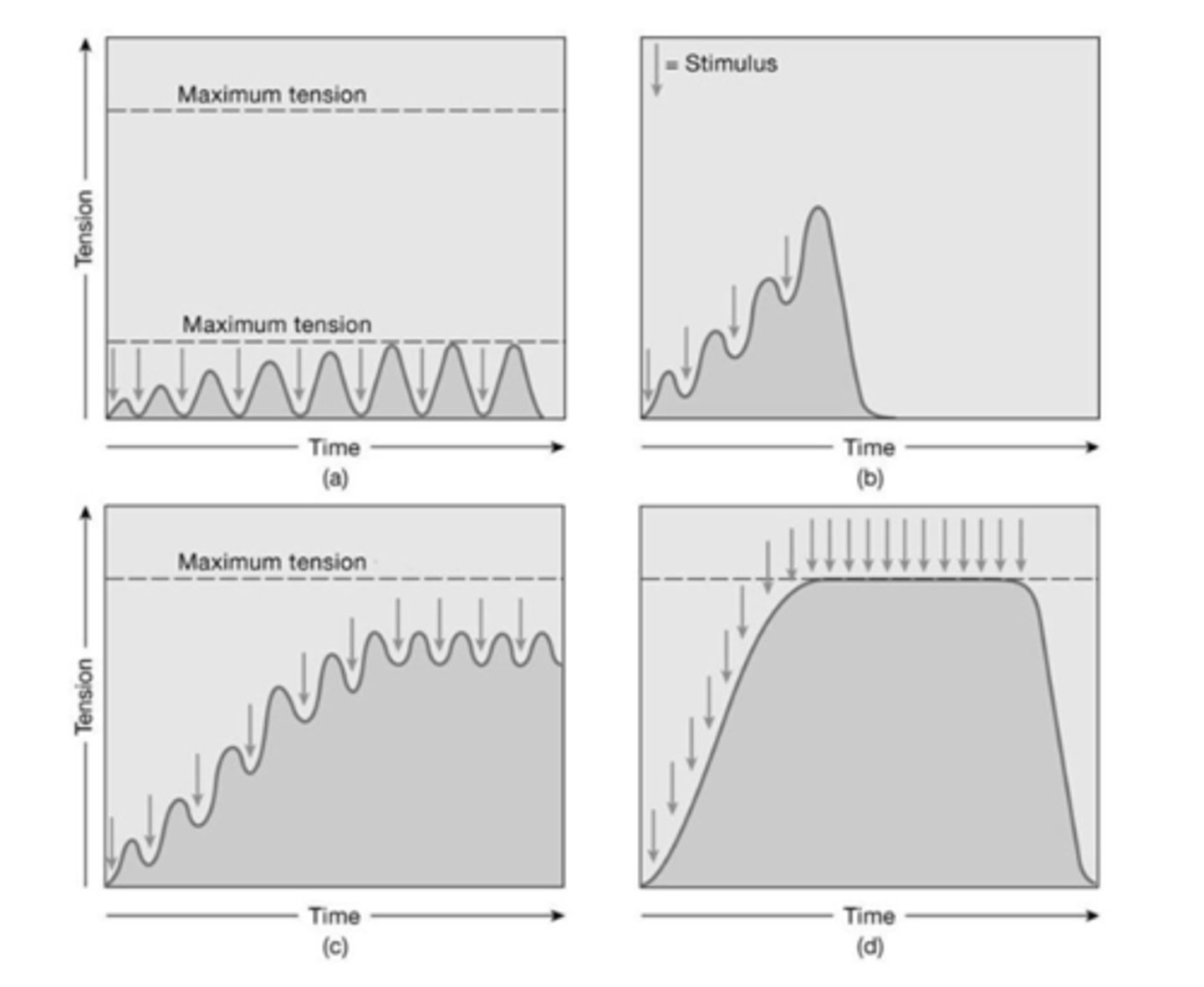
93) A single contraction-relaxation cycle in a muscle fiber produces a(n) A) cramp.
B) twitch.
C) tetanic contraction.
D) action potential.
E) motor unit.
B
94) A muscle produces its highest tension when in complete
A) recovery.
B) treppe.
C) wave summation.
D) aerobic metabolism.
E) tetanus.
E
95) During the time when the action potential moves through the sarcolemma a muscle twitch is in
A) contraction phase.
B) relaxation phase.
C) stimulus phase.
D) latent period.
E) isotonic period.
D
96) The point in a muscle twitch when the troponin is bound to calcium is called the
A) contraction phase.
B) relaxation phase.
C) stimulus phase.
D) latent period.
E) isotonic period.
A
97) Detachment of myosin cross-bridges occurs during the A) contraction phase.
B) relaxation phase.
C) stimulus phase.
D) latent period.
E) isotonic period.
B
98) A single motor neuron together with all the muscle fibers it innervates is called a(n) A) end foot.
B) end plate.
C) motor unit.
D) dermatome.
E) myotome.
C
99) The increase in muscle tension that is produced by increasing the number of active motor units is called
A) incomplete tetanus.
B) complete tetanus.
C) treppe.
D) wave summation.
E) recruitment.
E
100) The type of contraction in which the muscle fibers do not shorten is called
A) tetany.
B) treppe.
C) concentric.
D) isotonic.
E) isometric.
E